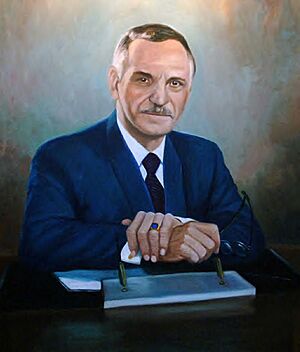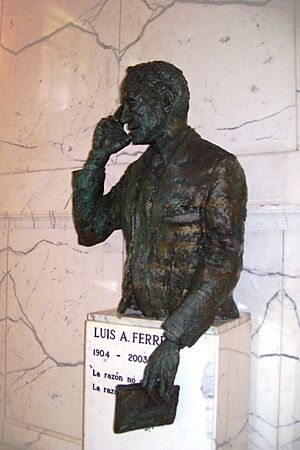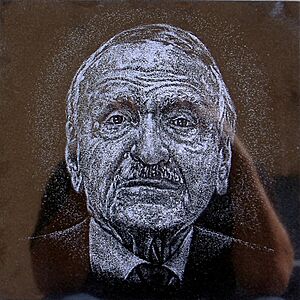Luis A. Ferré facts for kids
Quick facts for kids
Luis Ferré
|
|
|---|---|
 |
|
| 8th President of the Puerto Rico Senate | |
| In office January 1977 – January 1981 |
|
| Preceded by | Juan J. Cancel Ríos |
| Succeeded by | Miguel Hernández Agosto |
| Governor of Puerto Rico | |
| In office January 2, 1969 – January 2, 1973 |
|
| Preceded by | Roberto Sánchez Vilella |
| Succeeded by | Rafael Hernández Colón |
| Personal details | |
| Born |
Luis Alberto Ferré-Aguayo
February 17, 1904 Ponce, Porto Rico (now Puerto Rico) |
| Died | October 21, 2003 (aged 99) San Juan, Puerto Rico |
| Political party |
|
| Other political affiliations |
Republican |
| Spouses |
Lorenza Ramírez de Arellano
(m. 1931; died 1970)Tiody De Jesús
(m. 1980) |
| Children |
|
| Education | |
Don Luis Alberto Ferré Aguayo (February 17, 1904 – October 21, 2003) was an important figure in Puerto Rico. He was an engineer, a successful businessman, a politician, and someone who loved to help others and support the arts. He served as the governor of Puerto Rico from 1969 to 1973. Ferré also started the New Progressive Party, which believes Puerto Rico should become a state of the United States. For his great work, he received the Presidential Medal of Freedom, a very high honor.
Contents
Luis Ferré's Early Life and Education
Luis Alberto Ferré Aguayo was born in Ponce, Puerto Rico, a city in the south, on February 17, 1904. His grandfather was a French engineer who worked on the Panama Canal. Luis's father, Antonio Ferré Bagayado, was born in Havana, Cuba. He later moved to Puerto Rico and started a company called Puerto Rico Iron Works.
In Puerto Rico, Antonio Ferré married María Aguayo Casals. They had six children: Luis, José, Carlos, Hermán, Rosario, and Isolina. His sister Isolina later became a famous nun.
Luis Ferré went to the Massachusetts Institute of Technology (MIT) to study mechanical engineering. He earned his bachelor's degree in 1924 and his master's degree in 1925. He also studied music at the New England Conservatory of Music. While living in Boston, Ferré grew to admire the "American way of democracy."
Becoming a Successful Businessman
After finishing his studies, Ferré returned to Puerto Rico. He helped turn his father's company into a very successful business. This is how he made a lot of money.
In 1948, he bought a small newspaper called El Día. He later renamed it El Nuevo Día, and it became the most widely read newspaper in Puerto Rico. In the 1950s, Ferré's company, Empresas Ferré, bought Puerto Rico Cement and Ponce Cement. These companies did very well because Puerto Rico was experiencing a big economic growth. This growth was due to large industrial projects like Operation Bootstrap.
Luis Ferré's Political Journey
Ferré became involved in politics in the 1940s. He tried to become mayor of Ponce in 1940 and a representative in Washington D.C. in 1948, but he did not win those elections.
Serving as a Representative
In 1948, people in Puerto Rico were allowed to elect their own governor for the first time. Before that, the U.S. president chose the governor. Luis Muñoz Marín became the first elected governor.
In 1951, a vote was held to decide if Puerto Rico should create its own constitution. Ferré did not vote in this process at first. His political party, which wanted Puerto Rico to become a state, thought this process would make Puerto Rico a "colony" forever. However, Ferré later joined the group that wrote the constitution.
In 1952, the Constitution of Puerto Rico was approved. It changed Puerto Rico's official name to the Commonwealth of Puerto Rico. That same year, Ferré was elected as a representative in the Puerto Rico House of Representatives. He officially started his job on January 11, 1953.
Becoming Governor and Senator
On July 23, 1967, people in Puerto Rico voted again. They had to choose if they wanted to be an independent country, a U.S. state, or continue as a commonwealth. Most Puerto Ricans chose to remain a commonwealth.
Because of disagreements within the pro-statehood party, Ferré and others decided to start a new party. They founded the New Progressive Party (PNP).
In the next election in 1968, Ferré ran for Governor. He won by a small number of votes against Luis Negrón López. This win ended the 20-year control of the governor's office by the Popular Democratic Party.
During Ferré's time as governor, Puerto Rico's economy was growing fast. He worked to protect the federal minimum wage for workers and gave them a Christmas bonus. He even visited Puerto Rican soldiers in Vietnam. In 1970, his first wife, Lorencita, passed away. Their daughter, Rosario Ferré, who became a famous writer, then took on the role of First Lady.
Ferré cared a lot about young people. He helped change the Puerto Rico Constitution to lower the voting age to 18. He also supported youth organizations in his party and helped young people get important jobs in the government. He also made college scholarship programs stronger.
Before the U.S. government created the United States Environmental Protection Agency in 1971, Ferré had already created Puerto Rico's Environmental Quality Board in 1970. This board was in charge of protecting the island's environment.
In the 1972 elections, Ferré tried to be re-elected but lost to Rafael Hernández Colón. After his time as governor, Ferré remained active in politics. In 1976, he was elected to the Senate of Puerto Rico. He served as the president of the Senate from 1977 to 1981 and continued as a senator until 1985.
Years later, he married Tiody De Jesús, who was a nurse and later became a doctor.
A Man of Many Talents
Luis Ferré was also a very talented pianist. He even recorded several albums of his piano music. On January 3, 1959, he founded the Museo de Arte de Ponce (Ponce Art Museum) in his hometown. The museum first showed 71 paintings from his own collection. Today, it has over 3,000 art pieces. Ferré is famous for saving the painting Flaming June by Frederic Lord Leighton. He bought it in 1963 when it was not popular, and now it is a highlight at the museum.
The Luis A. Ferré Performing Arts Center in Santurce, Puerto Rico, is named after him. Also, the main highway connecting San Juan and Ponce is named the Luis A. Ferré Highway. He also helped create the Casals Festival and the Puerto Rico Conservatory of Music.
Ferré also enjoyed sports, especially fencing. There is an annual fencing championship in Puerto Rico named in his honor.
For all his good deeds and his support for democracy, he received the Presidential Medal of Freedom. President George H. W. Bush gave him this award on November 18, 1991.
Luis Ferré's Passing and Legacy

On September 29, 2003, Luis Ferré went to the hospital. He had surgery on October 1. While in the hospital, he got pneumonia and passed away on October 21, 2003, at 99 years old.
His body was placed in the capitol building in San Juan for people to pay their respects. Then, it was moved to his museum in Ponce. Finally, he had a state funeral and was buried in Ponce. Many politicians attended his funeral and honored him. He is buried at the Las Mercedes Memorial Park in Ponce.
Luis A. Ferré received many awards, including the Presidential Medal of Freedom. His sister, Sor Isolina Ferre, also received this same honor later. A famous sculptor named Tomás Batista made a sculpture of Ferré, which is displayed at the Ponce Museum of Art. Another sculpture of him was shown in 2008 at the Senate of Puerto Rico.
In 2004, a historic building in Ponce, the United States Courthouse and Post Office Building, was renamed the Luis A. Ferré United States Courthouse and Post Office Building by the U.S. Congress.
In November 2010, a part of Las Américas Avenue in Ponce was renamed the Luis A. Ferré Boulevard to honor him. This part of the road includes the Museo de Arte de Ponce and the Pontifical Catholic University of Puerto Rico.
See also
 In Spanish: Luis A. Ferré para niños
In Spanish: Luis A. Ferré para niños
- Sor Isolina Ferré
- List of governors of Puerto Rico
- List of political parties in Puerto Rico
- Politics of Puerto Rico
- List of Puerto Rican Presidential Medal of Freedom recipients



